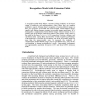Free Online Productivity Tools
i2Speak
i2Symbol
i2OCR
iTex2Img
iWeb2Print
iWeb2Shot
i2Type
iPdf2Split
iPdf2Merge
i2Bopomofo
i2Arabic
i2Style
i2Image
i2PDF
iLatex2Rtf
Sci2ools
67
Voted
IWANN
1997
Springer
1997
Springer
Recognition Model with Extension Fields
A recognition model which defines a measure of shape similarity on the direct output of multiscale and multiorientation Gabor filters does not manifest qualitative aspects of human object recognition of contour-deleted images in that: a) it recognizes recoverable and nonrecoverable contour-deleted images equally well whereas humans recognize recoverable images much better, b) it distinguishes complementary feature-deleted images whereas humans do not. Adding some of the known connectivity pattern of the primary visual cortex to the model in the form of extension fields (connections between collinear and curvilinear units) among filters increased the overall recognition performance of the model and: a) boosted the recognition rate of the recoverable images far more than the nonrecoverable ones, b) increased the similarity of complementary feature-deleted images, but not part-deleted ones, more closely corresponding to human psychophysical results. Interestingly, performance was approxi...
Complementary Feature-deleted Images | Contour-deleted Images | IWANN 1997 | Neural Networks | Recoverable Images |
Related Content
| Added | 08 Aug 2010 |
| Updated | 08 Aug 2010 |
| Type | Conference |
| Year | 1997 |
| Where | IWANN |
| Authors | Peter Kalocsai |
Comments (0)

